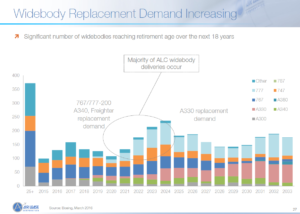Leeham News and Analysis
There's more to real news than a news release.
Will United’s new president open door for Airbus?

Scott Kirby moves from president of American Airlines to president of United Airlines. Photo via Google images.
Aug. 30, 2016, © Leeham Co.: Will Scott Kirby’s move from president of American Airlines to the same position at United Airlines lead to a major shift in fleet acquisition at the Chicago-based carrier?
This is an intriguing question that may take some time to answer.
Kirby spent 20 years with American CEO Doug Parker through their careers at America West Airlines, US Airways and American.
Boeing 787: Stable Rate, Hike Rate or Cut Rate
Aug. 2, 2016, © Leeham Co.: Boeing officials increasingly downplay the prospect of the 787 production rate increasing to 14/mo by the end of the decade from the current 12/mo, reflecting uncertainty over the strength of the wide-body market in the near-to-medium term.
Dennis Muilenburg, CEO of The Boeing Co., said during the company’s 2Q2016 earnings call July 27 that “we haven’t pinned down a specific decision point [on ramping up to 14/mo] yet because we’re going to keep a close eye on the market. The signals from our customers, we’ve got time to do our due diligence here.
“Our principle here is to keep wide body supply and demand in balance. And we’re confident in the 787 program across that span of scenarios, and we’re going to continue to work campaigns to fill out to the 14 a month rate step-up, and we’ll evaluate timelines and decisions around that. But you can be very confident that whatever we decide, we’re going to keep supply and demand in balance. We’re going to do it efficiently and productively, and all of this again is enveloped by our expectation of a year-over-year cash growth business.”
Boeing noted that the program is sold out in 2018 and has some slots available in 2019. At rate 12, the likelihood of these slots being filled may be challenging. Although the number itself isn’t great—27, according to Ascend—finding enough customers for delivery in 2019 could be challenging in the current soft environment, and with competition from a much lower priced Airbus A330, whether a CEO or NEO. The challenge becomes greater the farther out in the future.
If Boeing went to rate 14, this is another 24 airplanes per year that have to be sold. (Figure 1.)
Slowing economies begin to impact Airbus, Boeing
Subscription Required
Introduction

LatAm Airbus A350. LatAm may defer some A350s and/or Boeing 787s. Photo: Flickr via Google images.
June 13, 2016, © Leeham Co.: Signs are becoming more frequent that airlines are facing slowing economies around the globe, with impacts on existing orders in the backlog.
Last week JetBlue said it is trimming growth on rising fuel costs and softening revenue. LatAm also said last week that it plans to trim some Airbus A350 and Boeing 787 orders amid slumping traffic in Brazil. Delta Air Lines previously said it will defer four A350s and trimming growth due to slowing economy.
Summary
- Wide-body sales slowing this year.
- 787 Surplus developed.
- A330neo sales stall.
- A350-2000 on hold.
- 777 Classic sales stall.
- Cargo demand still anemic, says IATA.
Dissecting Wide-Body deliveries through 2030
Subscription Required.
Introduction
May 26, 2016, © Leeham Co.: A softening of trans-Atlantic air traffic, with declining yields and passenger demand, raises anew concerns that there is an oversupply and over-ordering of twin-aisle aircraft.
Air Lease Corp. addressed this concern at its May 19 investors day, arguing that growth plus retirements over the next 25 years more than supports the orders.
ALC, which is headed by Steve Udvar-Hazy and John Plueger, considered two of the leaders of the lessor industry, note that there is an average of about 150 wide-bodies approaching 25 years in age each year for the next 20 years. Coupled with long-haul traffic growth, ALC—which has a modest number of wide-body orders—is comfortable with the future supply-demand.
We’ve dissected the known delivery dates of wide-bodies at Airbus and Boeing, using the Ascend data base as of January. Wide-body orders have been announced subsequently, but not all have been firmed up and the total number won’t materially affect the trend lines.
Summary
- We look at announced production rates by 2020 of Airbus and Boeing. We don’t include our own forecasts.
- We look at the defined delivery dates of the A330, A350, A380, 747-8, 777 and 787. These are all models, including ceo/neo and Classic/X.
- We look at factors that indicate a softening of wide-body demand across the Atlantic.




 Our coverage of the Farnborough Air Show begins today with an interview with Fred Comer, president of Bombardier Commercial Aircraft. There will be paywall and freewall posts throughout the FIA16 this week.
Our coverage of the Farnborough Air Show begins today with an interview with Fred Comer, president of Bombardier Commercial Aircraft. There will be paywall and freewall posts throughout the FIA16 this week.




Dearth of wide-body order hang over Airbus, Boeing
Subscription Required
Introduction
July 25, 2016, © Leeham Co.: It wasn’t a good two weeks for wide-body airplanes.
Airbus, responding to a leak to the Paris newspaper La Tribune, confirmed it will reduce production for the A380 from 20/yr in 2017 to 12/yr in 2018—returning the program to a loss.
Boeing firmed up an MOU announced at the Paris Air Show with Volga Dnepr for 20 747-8Fs, but wouldn’t say how many are firm orders and how many are options.
Week 2: Boeing took nearly $1.7bn in after-tax write downs for the 787 and 747-8 programs.
And, while not directly tied to wide-bodies per se, Delta Air Lines announced it will reduce its trans-Atlantic services for a variety of reasons. Most of these services are performed with wide-body aircraft.
Summary
Read more
Leave a Comment
Posted on July 25, 2016 by Scott Hamilton
Airbus, Airlines, American Airlines, Boeing, Delta Air Lines, Leeham News and Comment, Premium
747-8, 787-10, 787-9, A350-900, A380, Airbus, American Airlines, Boeing, Delta Air Lines, Emirates Airline, Volga-Dnepr